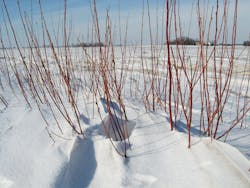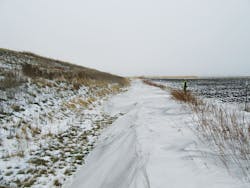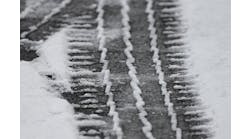By: Diomy Zamora and Eric Ogdahl Contributing Authors
For some, imagining farm country in the winter can conjure up peaceful bucolic scenes of snow blanketing an expansive and dormant landscape—the crops have been harvested, and it is a state of rest.
On the roads, however, these landscapes receive such snow in the winter as to create a state of anxiety and risk for many driving over them. When strong winds blow across barren fields in the winter, they can easily lift off fallen snow particles from the ground and transport them to adjacent roadways. This can create a number of hazardous conditions for drivers, such as reduced visibility and icy roads, as well as increases in travel time, snow-removal costs and road salt applications.
Fortunately, many transportation agencies in cold-weather regions have considered preventive methods to control blowing and drifting snow on roads. One such method is the use of living snow fences (LSFs), which are windbreaks of trees, shrubs or grasses planted to keep snow and ice from blowing off of farm fields and onto adjacent roads. LSFs work by creating wind turbulence along the length of their barrier, causing blowing snow and ice particles to deposit around the fence in drifts instead of in the protected roadway. Most of the drifts form downwind of the snow fence, requiring it to be set back a certain distance from the protected roadway.
Indeed, LSFs have been shown to effectively reduce blowing snow and ice on roadways. For example, the Minnesota Department of Transportation (MnDOT) estimates an average of $14 in snow removal costs are saved for every dollar they invest in LSFs. In addition, LSFs can provide a number of environmental benefits, such a providing wildlife habitats and sequestering carbon dioxide in their leaves, shoots and roots.
However, in most cases, the state-owned rights-of-way are not wide enough to accommodate the setback distance for most LSFs, requiring they be placed on private land. This has led to a limited adoption of LSFs, despite their numerous benefits, to say nothing of the financial assistance provided by state and federal agencies for establishing LSFs. Statewide, MnDOT has identified 3,841 areas, totaling 1,233 miles, along state roadways where blowing snow is a severe problem. Of these problem areas, only about 22 miles, or less than 2%, have been addressed through landowner adoption of LSFs. Through surveys by the University of Minnesota Extension (UMNE) and MnDOT, landowners have cited multiple barriers to LSF adoption, including removing cropland from production, the hassle of and time spent installing LSFs, and risk of plant mortality.
Younger protection?
These survey results in part led researchers at UMNE and MnDOT to consider plants that could potentially meet the concerns of landowners and provide effective LSFs. What researchers came up with was a shrub often already seen in many roadside ditches throughout Minnesota: willows.
In addition to being native to much of the U.S. and Canada, willows have been researched extensively as a potential biomass crop for bioenergy. Due to many of their ecological and physiological adaptations, shrub-willows can provide fast and abundant growth, growing up to 10 ft during a single growing season, and producing many small-diameter. stems. Additionally, they are easily planted with dormant stem cuttings and their stems can be harvested every three to four years—after which they regenerate without having to be replanted—up to seven times during a plant’s lifecycle to maintain optimal growth. This high and perennial production of plant material, or biomass, has potential to provide a renewable fuel source, which has motivated researchers around the world to study and develop the best willow practices for different locations and environments.
Many of the characteristics that make willows suitable for biomass production, researchers have found, also make them suitable for a range of environmental applications, including LSFs. Willow researchers from the State University of New York in Syracuse began implementing and documenting shrub-willows for LSFs in the early 2000s. They found that shrub-willows had the ability to reach key growth parameters for controlling blowing snow sooner than species traditionally used in LSFs. Shrub-willows, they observed, had potential to prevent blowing snow on roadways as soon as three years after planting.
This contrasts with many species traditionally used in LSFs, such as spruce or juniper, which can require five to 20 years before providing effective LSFs. Many traditional LSF species also require multiple widely spaced rows for effective snow capture, whereas high-density shrub-willow LSF plantings may provide the same control in narrower planting arrangements and thus occupy less area.
Aside from research in New York, however, little had been done to assess the use of shrub-willows for LSFs. This motivated researchers in Minnesota to conduct their own study on the use of willows for LSFs. Through a project funded by MnDOT, UMNE researchers set up an experimental LSF in Waseca, Minn., on the north side of Trunk Highway (TH) 14. The location was selected in part due to strong northwest winds in the winter blowing across the crop fields and depositing snow on the highway.
Tracking its growth
Researchers wanted to test three willow varieties that had been previously grown in biomass studies throughout Minnesota and had good survival and growth. Additionally, these varieties were observed to produce dense shrubs with many stems, a characteristic important to trapping and blocking snow. The three willow varieties were tested in two LSF planting arrangements: two rows—the standard design for many of New York’s willow LSFs—and four rows. The motivation behind testing four-row arrangements was: If these LSFs were ever to be harvested for biomass, two rows could be harvested one year, while leaving the other two rows for snow storage, thereby allowing for a staggered harvest of rows. Researchers were interested in which varieties and planting arrangements had the best establishment and provided the most snow capture.
The study was conducted on a MnDOT right-of-way on TH 14. The study was made up of plots 60 ft in length, which were assigned to one of three willow varieties and one of two planting arrangements. Each combination of willow variety and planting arrangement was replicated four times, for an experimental LSF about 0.25 miles in length. The willows in each plot were planted from dormant, 8-in. stem cuttings from a nursery in New York. The cuttings are easily planted by simply sticking the cutting into the soil by hand and leaving about 2 in. of the cutting aboveground, exposing a few buds from which the stems can develop. Willow cuttings were spaced 2 ft apart within rows and 2.5 ft apart between rows. After planting, the study was managed for weeds through a combination of post-emergent herbicide applications and hand weeding. After the first growing season and first winter of the study, willow stems were coppiced (cut off near the base of the plant) while still dormant to generate more stems and promote vigorous growth.
In the fall of 2014, one growing season after the willows were coppiced, plants in the study were assessed for survival, height and optical porosity (optical porosity is the amount of open space within the LSF when looking at it perpendicularly.) Together with height, optical porosity is a characteristic that determines how much snow a LSF can catch; in general, taller LSFs and those with a porosity of about 50% (equal amounts of open space and vegetation) provide the most snow capture. Porosity was measured by placing a large red backdrop behind the LSF and photographing the LSF in front of the backdrop. Pictures were then analyzed in an image-editing software to determine the percentage of backdrop pixels, or open space.
In addition to measuring different traits of the willow LSF, researchers also went out and measured the snow caught by the LSFs during the 2014-2015 winter season. This was done by measuring the heights of snowdrifts along a transect in each plot. Measurements were typically taken after recent snowfall events.
Researchers found willow varieties to have an average survival of about 90% and height of 3.3 ft after one growing season post-coppice. The porosity of the different LSF designs did not differ much among willow varieties, but in terms of planting arrangements, two rows had an average porosity of 87% while four rows had an average porosity of 80%. This likely translated to more snow capture in four-row arrangements. Throughout the 2014-2015 winter, all LSF designs caught around 2.2-3.3 tons of snow per linear meter of snow fence, with four-row arrangements catching about 20% more snow than two-row arrangements, on average.
Due to many above-freezing temperatures and rain events during the winter study period, it was difficult to compare the amount of snow caught by the willows LSFs to the amount of snow being blown across the area. However, using a combination of LSF and climatological models, researchers estimated that the heights and porosities of the different willow LSF designs would be sufficient to trap the average amount of blowing snow across the site within two to three growing seasons post-coppice. Ocular observation showed porosity in the willow systems decreased in Fall 2015, thereby increasing snow capture.
A strong capture
These results suggest that willows are a fast-growing plant that easily establishes a workable LSF. Given consistent heights and porosities among willow varieties in the study, multiple willow varieties may be incorporated into an LSF, which may be able to provide resilience to disease and pest outbreaks. Four-row arrangements may provide more snow capture earlier on than two-row arrangements, although two-row LSFs may be adequate for snow capture in future years. Overall, willows can provide an easily planted low-maintenance shrub, although weed control, such as mulch or weed barrier fabric, is important during the establishment of LSFs. Furthermore, the relatively close spacing of willows provide for a much narrower LSF than many traditional LSF species, potentially requiring less space. These considerations could potentially improve adoption of LSFs by landowners and add to the LSF design practices of transportation agencies. R&B
About The Author: Zamora and Ogdahl are with the University of Minnesota Extension.



